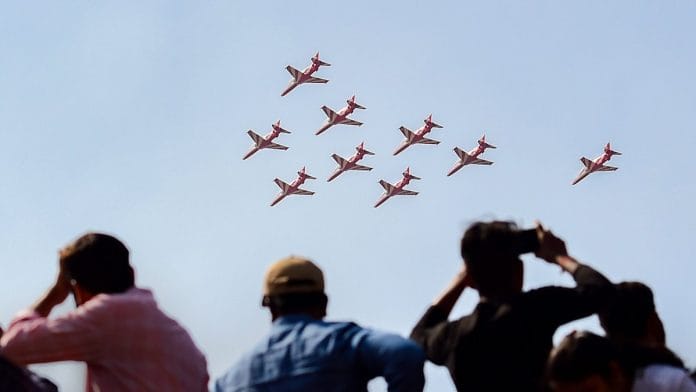New Delhi: The British-origin Hawk aircraft was supposed to be the saviour of the Indian Air Force’s Surya Kiran aerobatics team. Although the IAF has been using the Hawk Mk 132 since 2008, it was brought in to save the team in 2015, four years after Surya Kiran had been grounded due to a severe shortage of trainer jets.
However, tragedy struck Tuesday when two Hawks collided at the Yelahanka air force base near Bengaluru, killing one IAF wing commander and sending two other IAF pilot-officers and a civilian to hospital. The aircraft were rehearsing ahead of the biennial Aero India show.
According to Aviation Safety Network, there have been 179 reported incidents/accidents involving Hawk aircraft. ThePrint recounts the history of the Hawk, in India and abroad.
What is the Hawk?
The Hawk is a single-engine, jet-powered advanced training aircraft. British company BAE Systems produces this aircraft.
The Hawk first flew in 1974 at Dunsfold, Surrey, UK. Currently, Hawks operate in 12 countries, including India, the UK, Australia, Canada and Saudi Arabia.
The aircraft is used for ground attacks, flying training, weapons training, and aerobatics. While it is predominantly used for training, the Hawk is a fully combat-capable aircraft, with the capacity to launch both air-to-air and air-to-ground attacks.
Also read: Two IAF Surya Kiran jets collide at Aero India rehearsal, one pilot dead
IAF and the Hawk
The variant used by India is the Hawk Mk 132, which is a tandem-seat aircraft. This means it has two seats next to each other. Thus, both the trainee and the pilot can operate the aircraft at the same time.
The IAF used the Hawk to fill up its missing capability gap between basic piston-engine trainers and advanced fighter aircraft. IAF recruits use the Hawk during Stage-III of their training, before they graduate to supersonic jets such as Jaguars, MiG-21s and Mirage 2000s.
A Rolls-Royce Ardour Mk 871 twin-spool turbofan engine powers the Hawk Mk 132. It has a range of 2,520 km and a top speed of 1,065 km per hour. The aircraft has a fuel capacity of 2,805 litres.
A long wait
The IAF first articulated its requirements for an advanced jet trainer (AJT) back in 1982. The contract for the Hawks was signed 22 years later, in 2004, and the first two aircraft were delivered in 2007.
While some of the Hawks were bought directly from BAE Systems, India’s Hindustan Aeronautics Limited (HAL) was given the contract to assemble a majority of them domestically.
Together, the HAL and BAE Systems have developed a large assembly line of Hawks. At present, India owns the world’s largest fleet of Hawks outside the UK — today IAF’s fleet includes 123 Hawk advanced jet trainers.
India’s Hawks are stationed at the Bidar Air Force Station, one of the IAF’s premier flying training establishments.
Also read: A history of air show accidents around the world, the worst killed 77 in Ukraine
Resurrection of Surya Kiran
Surya Kiran was established in 1996, when India was set to host its first major air show. The organisers felt that it would be best to invite seasoned aerobatic teams from across the world, but the IAF thought otherwise. They argued that the world’s fourth largest air force was capable of a fine aerobatics team. The team was named ‘Surya Kiran’, a ray of sunshine, signifying hope.
This team would go on to become the world’s youngest nine-member aerobatics team, but the aforementioned shortage of trainer jets grounded it in 2011. The introduction of the Hawk resurrected Surya Kiran in February 2015.
According to the HAL website, “the aircraft [Hawk] is cleared for a wide range of aerobatic manoeuvres and exhibits very good resistance to departure even outside the normal flight envelope”.






